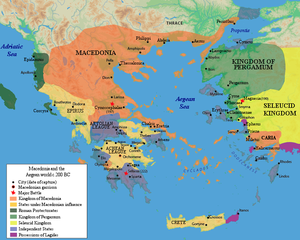- Battle of Cynoscephalae
-
- For the earlier battle fought here, see Battle of Cynoscephalae (364 BC).
Battle of Cynoscephalae Part of the Second Macedonian War 
A map showing the location of Cynoscephalae.Date 197 BC Location Thessaly Result Decisive Roman victory Belligerents Roman Republic
Aetolian League alliesMacedon Commanders and leaders T. Quinctius Flamininus Philip V of Macedon Strength about 33,400 men or about the same number as the Romans according to Plutarch [1] 25,500 men according to Plutarch [2] Casualties and losses about 2,000 killed or wounded 8,000 killed, 5,000 captured - Aous
- Cynoscephalae
The Battle of Cynoscephalae was an encounter battle fought in Thessaly in 197 BC between the Roman army, led by Titus Quinctius Flamininus, and the Antigonid dynasty of Macedon, led by Philip V.
Contents
Prelude
Flamininus, with his allies from the Aetolian League, was stationed at Thebes, and marched out towards Pherae in search of Philip, who was at Larisa. When Flamininus began his march to Larisa he had under his command about 32,500 to 33,400 soldiers. Besides the usual Roman troops and auxiliary units that would appear in any Roman army Flamininus's forces also included soldiers from the allied Aetolian League, light infantry from Athamania, mercenary archers from Crete, and elephants and Numidian cavalry from King Masinissa of Numidia. Philip had about 16,000 heavy infantry in phalanx formation, 2,000 peltasts, 5,500 light infantry from Illyria, Thrace, and Crete, and 2,000 cavalry for 25,500 troops overall. The two armies met near Pherae, and Philip's troops were defeated in a cavalry skirmish on the hills outside the city. Both sides then marched toward Scotusa in search of food, but out of sight of each other because of the hills.
Battle
During the march there was a heavy rainstorm, and the morning after there was a fog over the hills and fields separating both camps. Despite this, Philip resumed his march, and his troops became confused and disoriented due to heavy fog. Philip then sent a small force to take the Cynoscephalae hills. Flamininus, still unaware of Philip's location, sent out some cavalry and light infantry to reconnoiter, which engaged Philip's troops on the hills. The battle on the hills grew fierce and Flamininus sent 500 cavalry and 2,000 infantry as reinforcements, mostly Aetolians, forcing Philip's men to withdraw further up the hill. Philip now sent more men into the melee, his Macedonian and Thessalian horse, who drove the Romans down the hill, until the Aetolian cavalry stabilized the situation. Philip, though reluctant to send his phalanx into the broken, hilly terrain eventually ordered an assault with 8,000 men when he heard of the Roman retreat. Flamininus positioned his troops on the field as well. He left his right wing in reserve, with his elephants in front, and personally led the left wing against Philip. Meanwhile Philip's phalanx had reached the summit, and after joining with their light troops and cavalry which he placed on his right wing, Philip had his phalanx charge down the hill into the oncoming legionaries. As the Roman left was slowly being driven back, Flamininus took command of his right and ordered an assault there.
Philip's right wing was now on higher ground than the Roman left, and was at first successful against them. His left wing and center, made up of another 8,000 phalangites, however were still disorganized and in marching formation, so they had not even formed the phalanx yet, and as Flamininus sent his elephants charging into them, they routed. After breaking through, one of the Roman tribunes took twenty maniples (a smaller division of the legion) and attacked the Macedonian right wing from behind. The Macedonians were unable to reposition themselves as quickly as the Roman maniples. Now surrounded by both wings of the Roman legion, they suffered heavy casualties and fled.
Aftermath
After a brief pursuit, Flamininus allowed Philip to escape. According to Polybius and Livy, 5,000 Macedonians had been killed. Livy mentions that other sources claim 32,000 Macedonians were killed and even one writer who due to "boundless exaggeration" claims 40,000 but concludes that Polybius is the trustworthy source on this matter.[3] Flamininus also took 1,000 prisoners. The Romans lost about 2,000 men.
This Macedonian defeat marks the passing of imperial power from the successors of Alexander the Great to Rome.[citation needed] With the later Battle of Pydna, this defeat demonstrates the superiority of the Roman legion over the Macedonian phalanx. The phalanx, though very powerful head on, was not as flexible as the Roman manipular formation. Although the peace that followed allowed Philip to keep his kingdom intact as a buffer state between other Greek states and Illyria, Flamininus proclaimed that the Greek states previously under Macedonian domination were now free. Philip also had to pay 1,000 talents of silver to Rome, disband his navy and most of his army, and send his son to Rome as a hostage.
Literature
- N.G.L. Hammond, "The Campaign and Battle of Cynoscephalae in 197 BC" in Journal of Hellenic Studies 108 (1988)
- Polybius, Histories, Bk XVIII.19–27.
External links
Notes
Categories:- 2nd-century BC conflicts
- Battles involving the Roman Republic
- Battles of Philip V of Macedon
- Battles involving Pergamon
- 197 BC
- Battles in Hellenistic Thessaly
- Second Macedonian War
Wikimedia Foundation. 2010.

